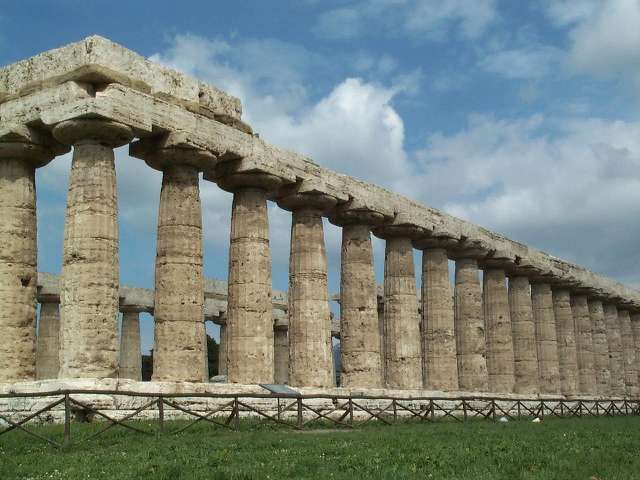![]()
Naples's classical sites
|
|
Naples's classical sites |

Paestum, South of Naples
| Naples's classical sites |
| Naples was a perfect place to
land to see some of Italy's classical gems : Pompeii, Herculaneum and
Paestum ! On our first day in Europe, we made it through Naples and its
crazy drivers. Crazy drivers ? Surely, if you've made it through India,
Teheran and Cairo, you can deal with Naples ? The difference is in Naples
they go 3 times as fast ! Troopie was frightened and had trouble keeping
up. But there was an even better surprise for us : that week was
"Culture Week" in Italy with ALL sites and museums free !
|
|
|
|
Before there were too little directions, around Naples there were too many ! Notice the 3D Vesuvius !
|
| "The
79 A.D. eruption of Vesuvius was the first volcanic eruption ever to be
described in detail. From 18 miles (30 km) west of the volcano, Pliny the
Younger, witnessed the eruption and later recorded his observations in two
letters. He described the earthquakes before the eruption, the eruption
column, air fall, the effects of the eruption on people, pyroclastic
flows, and even tsunami. Volcanologists now use the term
"plinian" to refer to sustained explosive eruptions which
generate high-altitude eruption columns and blanket large areas with ash.
It is estimated that at times during the eruption the column of ash was 20
miles (32 km) tall. About 1 cubic mile (4 cubic kilometers) of ash was
erupted in about 19 hours." (University of North Dakota, http://volcano.und.nodak.edu/).
This eruption obliterated the ancient Roman resort towns of Pompeii and
Herculaneum as it covered them in 3 meters of ashes.
|
|
|
|
Herculaneum : an interior courtyard and indoor mural paintings
|
| Walking through the streets
of a Roman city with so many of the buildings up and so fine details
remaining is an amazing experience. That day the natural development of
cities that occurs with time stopped. Buried under several meters of ash,
fragile items such as paintings or furniture have been remarkably
preserved. As in many other surviving Roman cities, the streets are marked
by ruts left by the passing of carriages.
|
|
|
|
A Herculaneum mosaic : Neptune et Amphitrite in the House of the "Mosaico di Nettuno e di Anfitrite"
|
| We headed South for the very
scenic coast of Amalfi for our next stop. Paestum must rank amongst the
most breathtaking remains from classical antiquity. It boasts a collection
of stunning Greek temples. In contrast to many city temples, Paestum's
gleaming white marble temples are set in a park near the blue
Mediterranean Sea.
|
|
|
|
Paestum's Temple of Athena, 500 B.C. (left)
|
| Paestum and the Amalfi coast
is where the 2003 Pirelli calendar was shot ! Would anyone like to know
more about this ? http://www.pirelli.com/en_42/this_is_pirelli/communication/calendar/the_calendar.jhtml?s1=4200019&s2=4200043&s3=4200101&s4=-1
|
|
|
|
Check Christian's sunglasses out (left), a local souvenir shop (right)
|
| Our last stop was famous
Pompeii. After having circled around the Mediterranean from Turkey to
Tunisia and from Lebanon to Libya, these are going to be our last Roman
ruins for some time. Lafayette, Indiana anyone ?
|
|
|
| Here are our extra pages on Italy : |
|
|
|
|
Naples's classical sites |
We are doing well !
| Coming from Tunisia | Back to Trip page | Heading to Switzerland |